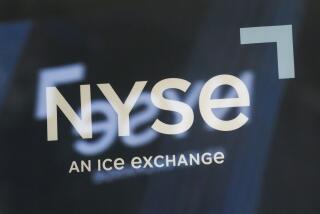‘Real Return,’ Real Concerns : Inflation-Indexed U.S. Bonds Are About to Go on Sale--but Don’t Rush Into Anything
- Share via
They say everything old can be new again. But they probably aren’t thinking about inflation.
Still, there are those American investors who strongly believe current tame inflation levels of 3.3% could skyrocket back to the 13% level the United States saw in 1980 or even higher--that it’s only matter of time.
And for those folks, Uncle Sam may have just the investment: so-called real-return bonds, which would rise in value to compensate for any inflation.
These “inflation-indexed bonds,” scheduled to go on sale in just eight days, are not only a new type of bond, they are also a “whole new asset class,” said John Brynjolfsson, a portfolio manager with Newport Beach-based Pacific Investment Management Co., which manages more than $65 billion of bonds.
Today, after a my Secretary Robert E. Rubin will announce at an 11 a.m. EST news the size of the Treasury’s first offering of the inflation-indexed bonds.
The first bonds will be sold in 10-year maturities with an expected annual interest rate of between 3% and 4%. That’s far below the yield on a traditional 10-year Treasury note, currently 6.55%.
However, because the bonds’ principal will grow to match any rise in inflation as measured by the consumer price index, investors are guaranteed a positive real return on the new bonds--the annual interest rate--even if inflation soars.
By contrast, loss of purchasing power is the biggest risk with traditional fixed-rate bonds, which can fall in value if inflation rises.
What do the feds get in offering inflation-indexed bonds? The government hopes the bonds will lower its borrowing costs, assuming inflation stays subdued. A potential side benefit is that the Federal Reserve Board will have a better gauge of investors’ inflation expectations as it watches the value of the bonds once they begin trading.
Some investors may want the bonds as a diversification tool, but they are not likely to supplant other types of vehicles such as annuities or savings accounts.
Who would benefit from these bonds? Retired people who need to protect their purchasing power could find the bonds attractive, but younger people following a more aggressive investing strategy probably won’t find them appealing.
“It’s just not clear how popular they will be with individuals. These products are for people who don’t want the risk of inflation--it’s plain and simple,” said John Ziegelbauer, a senior manager in the Washington office of Grant Thornton, a national accounting firm specializing in taxes.
How does this new animal work?
Let’s say you buy a $1,000 inflation-indexed bond that pays a 3% interest rate. Now assume annual inflation rockets to 20% this year. The bond’s principal would rise to $1,200 and your interest payment for the year would be $36--that’s 3% of the new year-end bond face value of $1,200.
But that $200 inflation adjustment wouldn’t be paid in cash. It’s just added on to the principal and is only received when the bond is redeemed or sold.
What if the opposite occurs and inflation, 3.3% in 1996, drops to 2% this year?
An inflation-indexed bond issued for $1,000 would increase in face value by $20 this year if inflation is 2%. The interest payment on the bond for the year would be $30.60, or 3% of $1,020.
But most important, analysts warn investors to consider tax concerns before deciding to buy the bonds.
Because all earnings, including the official increase in principal value, on the bonds will be subject to federal income taxes if the bonds aren’t in tax-sheltered accounts, inflation-related appreciation might cause some individual investors to pay more in taxes than they receive in actual interest payments in any given year.
That means that if an investor is depending on the bonds for current income, he or she could have years when the income actually received is less than the taxes due, Ziegelbauer said. Those risks aren’t great, but they do exist.
For example, if you’re in the lowest, 15% federal tax bracket, inflation would have to reach very high levels of 20% before the tax bill caused by principal appreciation outstripped your annual interest payout.
If you are in the more common 28% bracket, that relationship would go against you at an 8.5% inflation rate. If you’re in the top, 39.6% tax bracket, you would pay more than you would take in once inflation topped 5%, according to Ziegelbauer’s research.
For example, let’s take an investor in the 39.6% bracket who buys a $1,000 bond yielding 3%. If inflation rises to 8% for the year, that investor would get interest payments of $32.40 on the bond for that year. But the tax liability on the interest and principal appreciation that year would be $44.51, or $12.11 more than his or her interest earnings.
The way around this risk for most investors is simply to hold the bonds in a tax-deferred or tax-sheltered account such as a 401(k) or individual retirement account.
Despite the tax concerns, “these bonds will have some interesting applications down the road when people get comfortable with them,” Ziegelbauer said.
They are predicted to hold special attraction for investors nearing retirement or in their early retirement years, who can buy them for their IRAs. Because the bonds are specifically designed to preserve your capital, they can provide some ballast for an investor’s portfolio--especially if there is a stock market meltdown.
Although similar inflation-indexed bonds have not been a huge hit among investors in Canada and Britain, supporters think there will be an appetite for the bonds here, given the number of retired Americans looking for diversification.
“People can look forward to protecting their purchasing power,” said Pete Hollenbach, public affairs officer with the U.S. Treasury.
To attract small investors, the bonds will be sold in denominations as low as $1,000, but initially the bonds are expected to be more popular among institutional investors.
Small investors can buy inflation-indexed bonds directly with no fees by getting applications from the nearest Federal Reserve Bank or by calling (202) 874-4000.
Investors can also buy the bonds through a broker. Down the road, companies may make the bonds an option in 401(k) plans.
American Century Investments of Mountain View, Calif., formerly known as the Benham Group, will in February open a new mutual fund that will own inflation-indexed bonds. The fund, to be called the American Century Benham Inflation Adjusted Treasury Fund, will be intended for individual investors who want some ballast for their portfolios--and who don’t want to be locked into owning an individual bond for 10 years, said James A. Benham, spokesman for the company.
Several investors have called expressing interest, but it will be hard to predict the response, he said. “All systems are go. But we’re not sure what will happen.”
Benham said the response may echo what happened when the company started its first “zero coupon” Treasury bond fund in 1985. By the end of that year, only $10 million had trickled into the fund. The fund now holds more than $1.6 billion.
Pacific Investment Management Co., better known as PIMCO, will also start a mutual fund for the bonds, but it will be intended mainly for large institutions such as insurance companies. The fund will commingle the U.S. bonds with similar but higher-yielding inflation-indexed bonds sold by other countries such as New Zealand and Canada.
Nationwide, however, most individual investors and their financial planners are adopting a “wait and see” attitude when it comes to inflation-indexed bonds.
“Even though it is from the government, we are a little skeptical. We want to wait and see how these things look and feel in an investor’s portfolio,” said Charles Foster II, a certified financial planner in Del Mar, Calif. “We’re still a little cynical.”
Income investing and investing and taxes will be among the topics of the many panels at the Los Angeles Times Investment Strategies Conference on Feb. 22-23. For more information, call (888) TIMES97.
(BEGIN TEXT OF INFOBOX / INFOGRAPHIC)
California Municipal Bonds
T. Rowe Price & Associates tracks the yields of 20 California municipal bonds and the Bond Buyer Index of 40 national issues.
Five Widely Held California Bonds:
*--*
Yield Issue Coupon Maturity 1/10 Friday Calif. general obligation 10-yr (generic) 5.20% 5.15% Calif. general obligation 20-yr (generic) 5.70 5.70 Los Angeles MTA (insured) 5.50% 7/1/17 5.78 5.75 Calif. public works lease rev. 6.00 10/1/14 5.87 5.80 San Fran. airport (insured) 5.65 5/1/24 5.85 5.82
*--*
Source: T. Rowe Price & Associates in Baltimore, which manages a $150-million California bond fund
Note: All yields are as of 2 p.m. Friday. Yields are based on institutional trading, retail prices and a survey of California brokers. Yields offered to individual investors will vary.
More to Read
Inside the business of entertainment
The Wide Shot brings you news, analysis and insights on everything from streaming wars to production — and what it all means for the future.
You may occasionally receive promotional content from the Los Angeles Times.










